Analysis of New Zealand's Primary Health Care Strategy 2001 and Cancer
VerifiedAdded on 2022/08/15
|15
|3951
|9
Report
AI Summary
This report provides an in-depth analysis of New Zealand's healthcare system, specifically focusing on the Primary Health Care Strategy of 2001 and its implications. The report begins by outlining the structure of New Zealand's healthcare landscape, emphasizing the roles of public and private providers and the significance of primary, secondary, and tertiary prevention. It then delves into the introduction and objectives of the Primary Healthcare Strategy, highlighting its role in addressing health inequalities and improving public health outcomes. The report examines the strategy's focus on enhancing primary care services, improving access to care, and addressing population health. It further explores the impact of the strategy on cancer care, particularly breast cancer, detailing prevention strategies, early detection efforts, and the role of primary care providers. The report also discusses the importance of patient empowerment in chronic disease management, the role of nurses in healthcare, and the challenges faced by breast cancer patients.
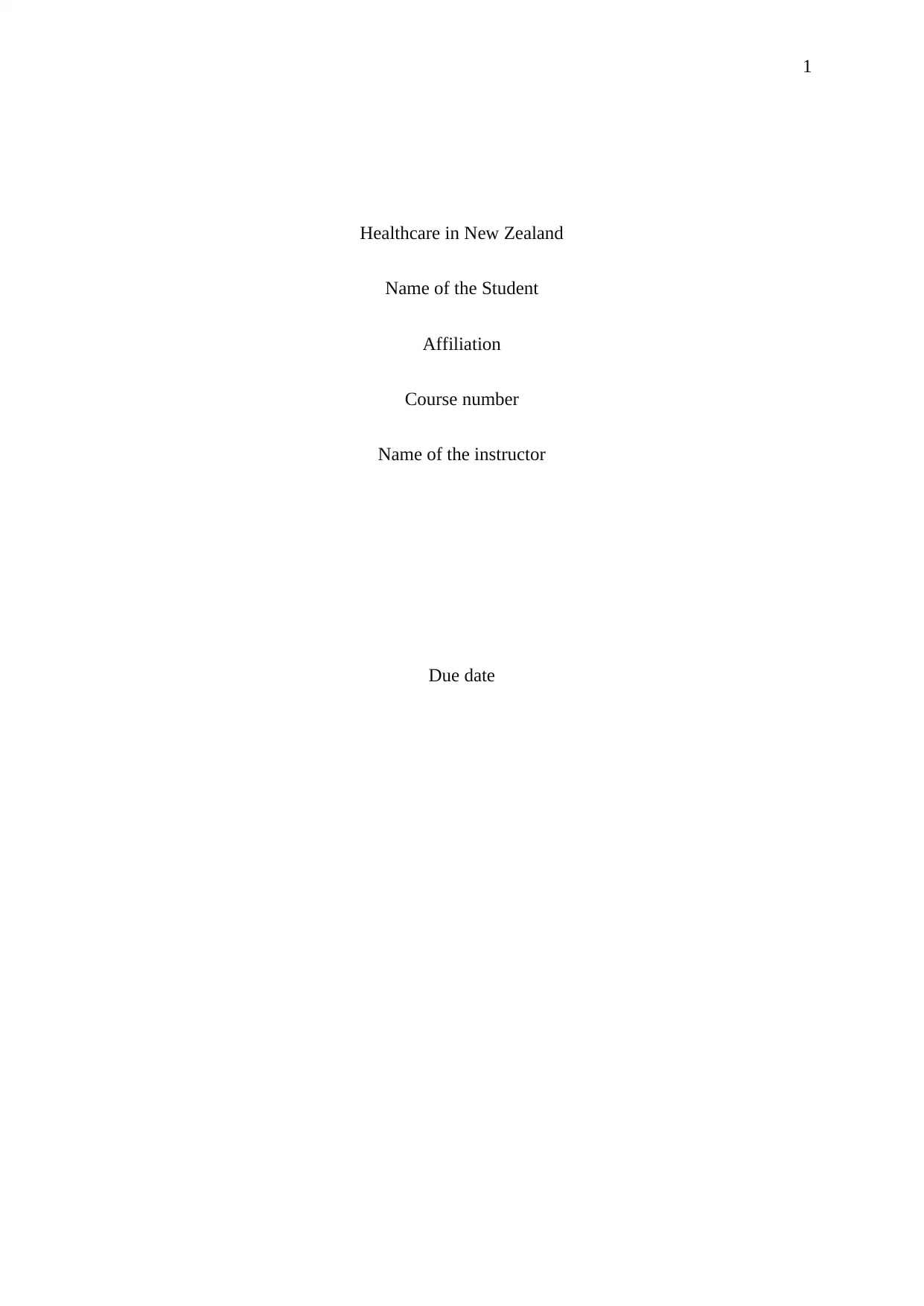
1
Healthcare in New Zealand
Name of the Student
Affiliation
Course number
Name of the instructor
Due date
Healthcare in New Zealand
Name of the Student
Affiliation
Course number
Name of the instructor
Due date
Paraphrase This Document
Need a fresh take? Get an instant paraphrase of this document with our AI Paraphraser
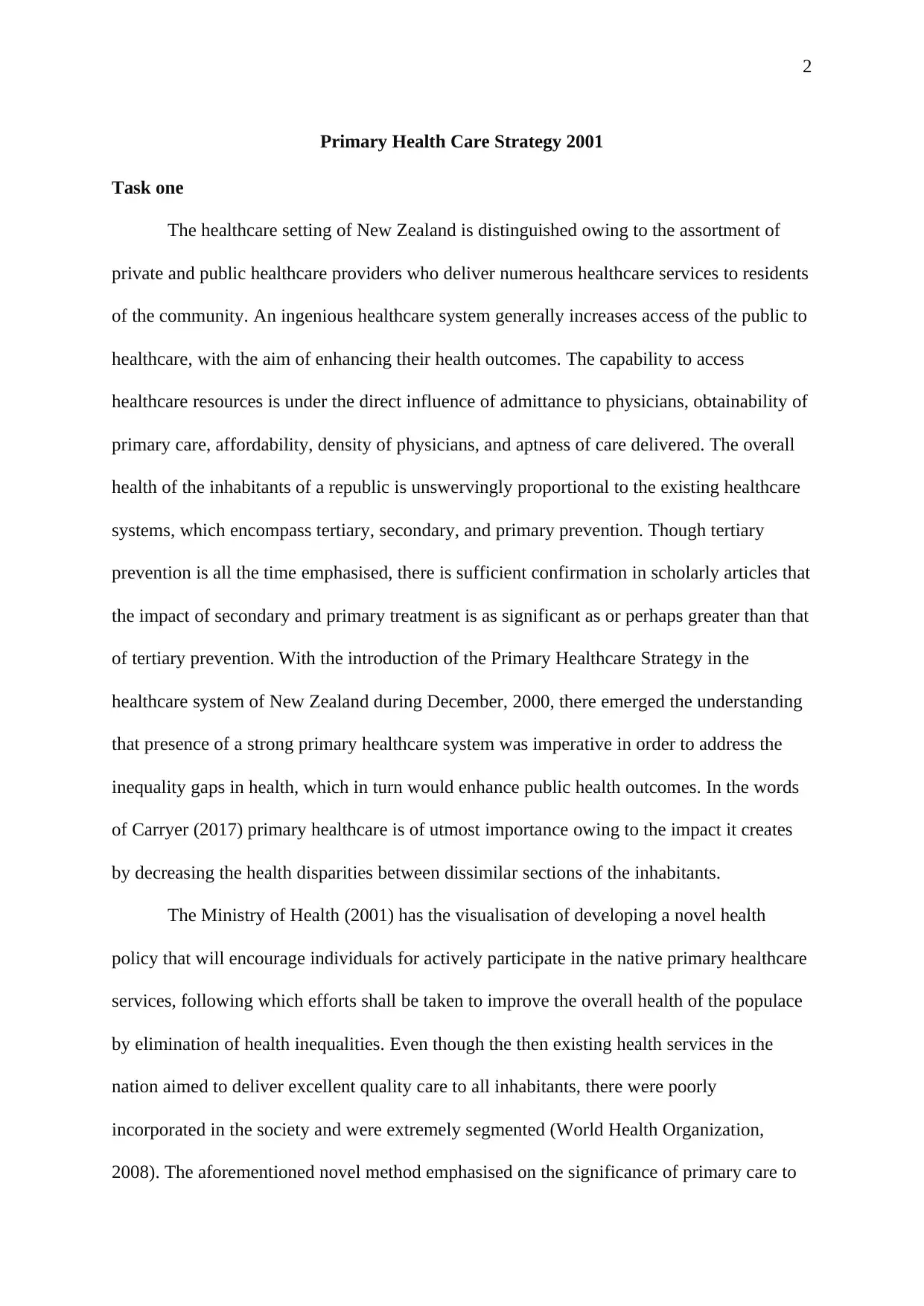
2
Primary Health Care Strategy 2001
Task one
The healthcare setting of New Zealand is distinguished owing to the assortment of
private and public healthcare providers who deliver numerous healthcare services to residents
of the community. An ingenious healthcare system generally increases access of the public to
healthcare, with the aim of enhancing their health outcomes. The capability to access
healthcare resources is under the direct influence of admittance to physicians, obtainability of
primary care, affordability, density of physicians, and aptness of care delivered. The overall
health of the inhabitants of a republic is unswervingly proportional to the existing healthcare
systems, which encompass tertiary, secondary, and primary prevention. Though tertiary
prevention is all the time emphasised, there is sufficient confirmation in scholarly articles that
the impact of secondary and primary treatment is as significant as or perhaps greater than that
of tertiary prevention. With the introduction of the Primary Healthcare Strategy in the
healthcare system of New Zealand during December, 2000, there emerged the understanding
that presence of a strong primary healthcare system was imperative in order to address the
inequality gaps in health, which in turn would enhance public health outcomes. In the words
of Carryer (2017) primary healthcare is of utmost importance owing to the impact it creates
by decreasing the health disparities between dissimilar sections of the inhabitants.
The Ministry of Health (2001) has the visualisation of developing a novel health
policy that will encourage individuals for actively participate in the native primary healthcare
services, following which efforts shall be taken to improve the overall health of the populace
by elimination of health inequalities. Even though the then existing health services in the
nation aimed to deliver excellent quality care to all inhabitants, there were poorly
incorporated in the society and were extremely segmented (World Health Organization,
2008). The aforementioned novel method emphasised on the significance of primary care to
Primary Health Care Strategy 2001
Task one
The healthcare setting of New Zealand is distinguished owing to the assortment of
private and public healthcare providers who deliver numerous healthcare services to residents
of the community. An ingenious healthcare system generally increases access of the public to
healthcare, with the aim of enhancing their health outcomes. The capability to access
healthcare resources is under the direct influence of admittance to physicians, obtainability of
primary care, affordability, density of physicians, and aptness of care delivered. The overall
health of the inhabitants of a republic is unswervingly proportional to the existing healthcare
systems, which encompass tertiary, secondary, and primary prevention. Though tertiary
prevention is all the time emphasised, there is sufficient confirmation in scholarly articles that
the impact of secondary and primary treatment is as significant as or perhaps greater than that
of tertiary prevention. With the introduction of the Primary Healthcare Strategy in the
healthcare system of New Zealand during December, 2000, there emerged the understanding
that presence of a strong primary healthcare system was imperative in order to address the
inequality gaps in health, which in turn would enhance public health outcomes. In the words
of Carryer (2017) primary healthcare is of utmost importance owing to the impact it creates
by decreasing the health disparities between dissimilar sections of the inhabitants.
The Ministry of Health (2001) has the visualisation of developing a novel health
policy that will encourage individuals for actively participate in the native primary healthcare
services, following which efforts shall be taken to improve the overall health of the populace
by elimination of health inequalities. Even though the then existing health services in the
nation aimed to deliver excellent quality care to all inhabitants, there were poorly
incorporated in the society and were extremely segmented (World Health Organization,
2008). The aforementioned novel method emphasised on the significance of primary care to
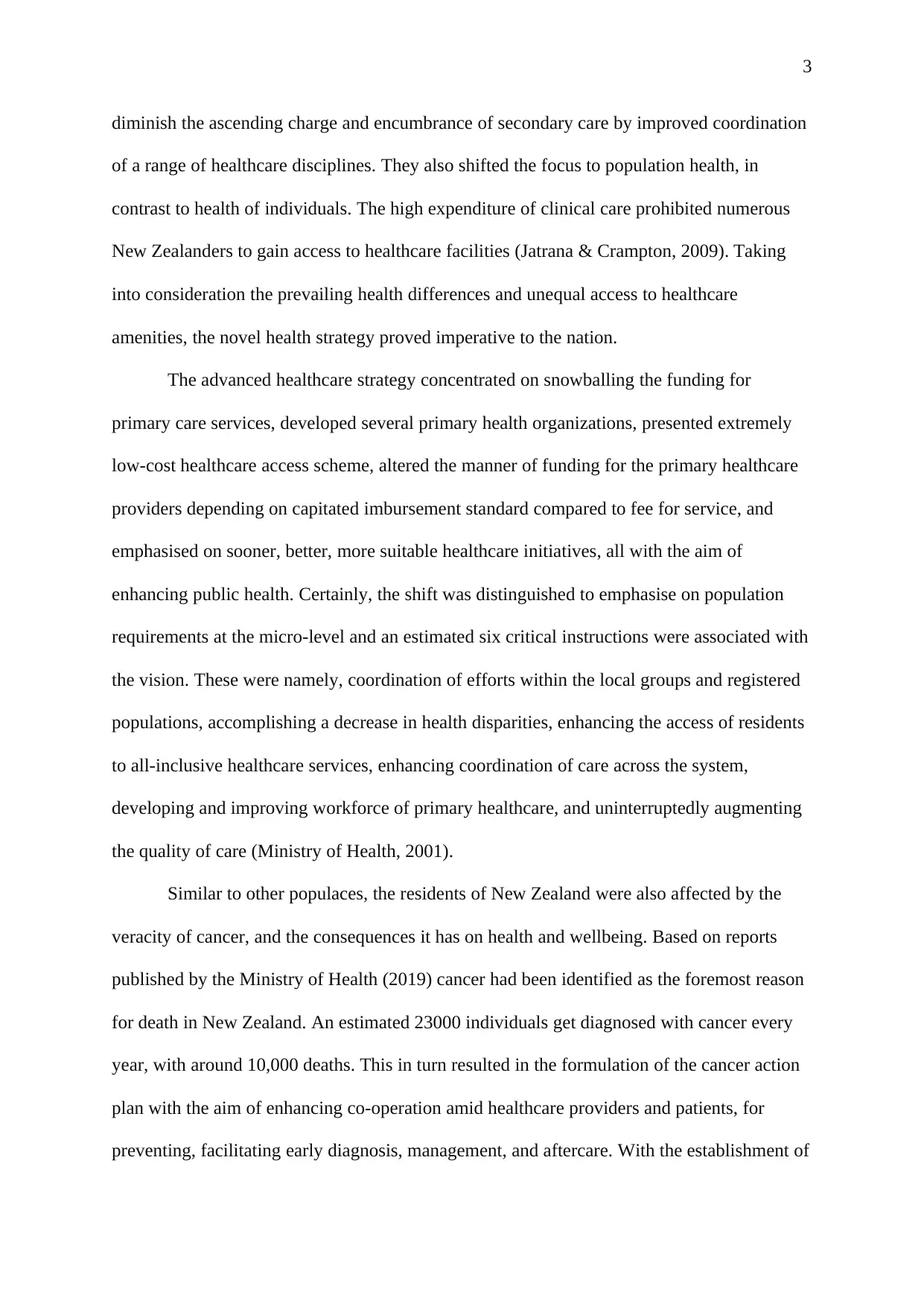
3
diminish the ascending charge and encumbrance of secondary care by improved coordination
of a range of healthcare disciplines. They also shifted the focus to population health, in
contrast to health of individuals. The high expenditure of clinical care prohibited numerous
New Zealanders to gain access to healthcare facilities (Jatrana & Crampton, 2009). Taking
into consideration the prevailing health differences and unequal access to healthcare
amenities, the novel health strategy proved imperative to the nation.
The advanced healthcare strategy concentrated on snowballing the funding for
primary care services, developed several primary health organizations, presented extremely
low-cost healthcare access scheme, altered the manner of funding for the primary healthcare
providers depending on capitated imbursement standard compared to fee for service, and
emphasised on sooner, better, more suitable healthcare initiatives, all with the aim of
enhancing public health. Certainly, the shift was distinguished to emphasise on population
requirements at the micro-level and an estimated six critical instructions were associated with
the vision. These were namely, coordination of efforts within the local groups and registered
populations, accomplishing a decrease in health disparities, enhancing the access of residents
to all-inclusive healthcare services, enhancing coordination of care across the system,
developing and improving workforce of primary healthcare, and uninterruptedly augmenting
the quality of care (Ministry of Health, 2001).
Similar to other populaces, the residents of New Zealand were also affected by the
veracity of cancer, and the consequences it has on health and wellbeing. Based on reports
published by the Ministry of Health (2019) cancer had been identified as the foremost reason
for death in New Zealand. An estimated 23000 individuals get diagnosed with cancer every
year, with around 10,000 deaths. This in turn resulted in the formulation of the cancer action
plan with the aim of enhancing co-operation amid healthcare providers and patients, for
preventing, facilitating early diagnosis, management, and aftercare. With the establishment of
diminish the ascending charge and encumbrance of secondary care by improved coordination
of a range of healthcare disciplines. They also shifted the focus to population health, in
contrast to health of individuals. The high expenditure of clinical care prohibited numerous
New Zealanders to gain access to healthcare facilities (Jatrana & Crampton, 2009). Taking
into consideration the prevailing health differences and unequal access to healthcare
amenities, the novel health strategy proved imperative to the nation.
The advanced healthcare strategy concentrated on snowballing the funding for
primary care services, developed several primary health organizations, presented extremely
low-cost healthcare access scheme, altered the manner of funding for the primary healthcare
providers depending on capitated imbursement standard compared to fee for service, and
emphasised on sooner, better, more suitable healthcare initiatives, all with the aim of
enhancing public health. Certainly, the shift was distinguished to emphasise on population
requirements at the micro-level and an estimated six critical instructions were associated with
the vision. These were namely, coordination of efforts within the local groups and registered
populations, accomplishing a decrease in health disparities, enhancing the access of residents
to all-inclusive healthcare services, enhancing coordination of care across the system,
developing and improving workforce of primary healthcare, and uninterruptedly augmenting
the quality of care (Ministry of Health, 2001).
Similar to other populaces, the residents of New Zealand were also affected by the
veracity of cancer, and the consequences it has on health and wellbeing. Based on reports
published by the Ministry of Health (2019) cancer had been identified as the foremost reason
for death in New Zealand. An estimated 23000 individuals get diagnosed with cancer every
year, with around 10,000 deaths. This in turn resulted in the formulation of the cancer action
plan with the aim of enhancing co-operation amid healthcare providers and patients, for
preventing, facilitating early diagnosis, management, and aftercare. With the establishment of
⊘ This is a preview!⊘
Do you want full access?
Subscribe today to unlock all pages.

Trusted by 1+ million students worldwide
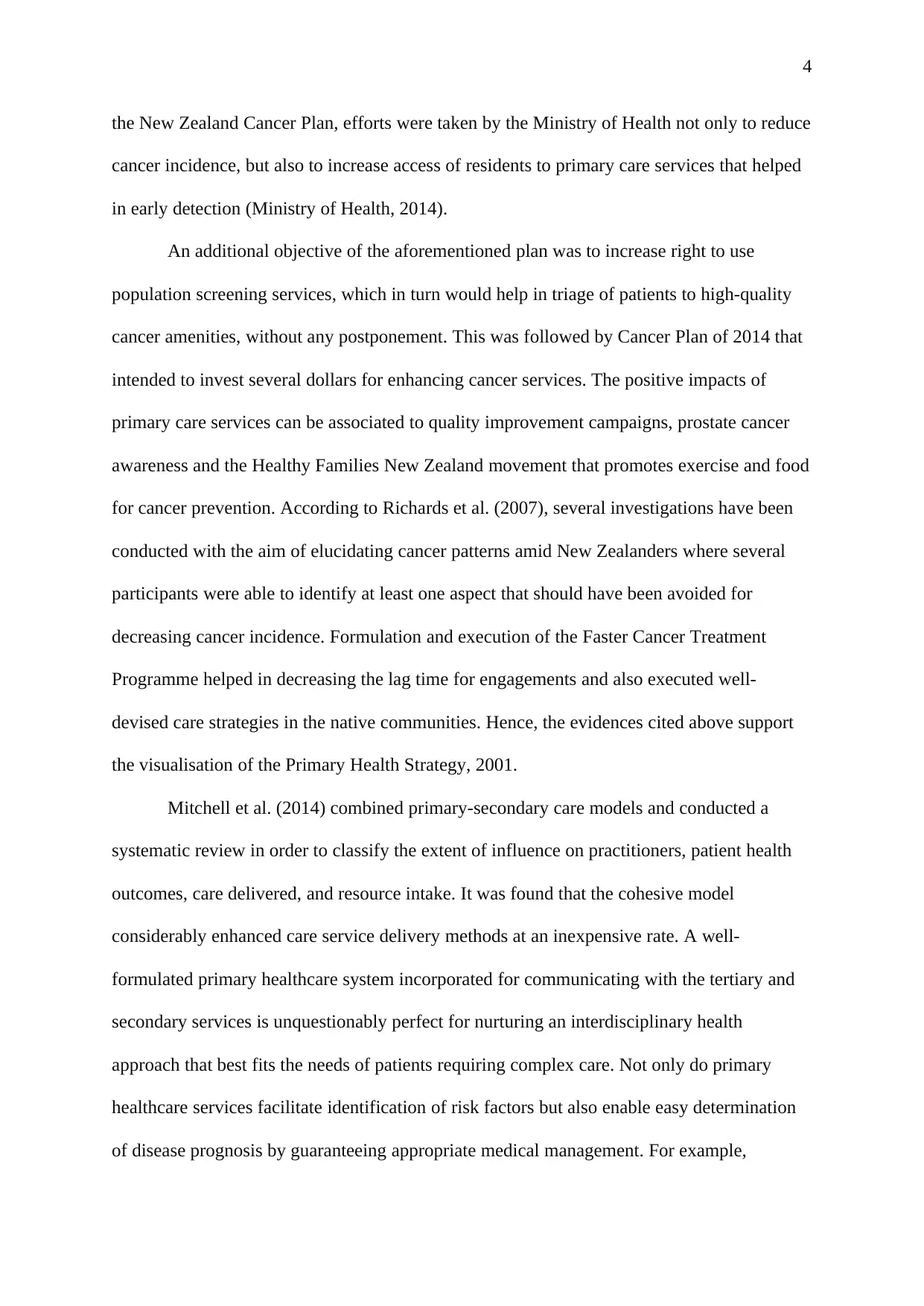
4
the New Zealand Cancer Plan, efforts were taken by the Ministry of Health not only to reduce
cancer incidence, but also to increase access of residents to primary care services that helped
in early detection (Ministry of Health, 2014).
An additional objective of the aforementioned plan was to increase right to use
population screening services, which in turn would help in triage of patients to high-quality
cancer amenities, without any postponement. This was followed by Cancer Plan of 2014 that
intended to invest several dollars for enhancing cancer services. The positive impacts of
primary care services can be associated to quality improvement campaigns, prostate cancer
awareness and the Healthy Families New Zealand movement that promotes exercise and food
for cancer prevention. According to Richards et al. (2007), several investigations have been
conducted with the aim of elucidating cancer patterns amid New Zealanders where several
participants were able to identify at least one aspect that should have been avoided for
decreasing cancer incidence. Formulation and execution of the Faster Cancer Treatment
Programme helped in decreasing the lag time for engagements and also executed well-
devised care strategies in the native communities. Hence, the evidences cited above support
the visualisation of the Primary Health Strategy, 2001.
Mitchell et al. (2014) combined primary-secondary care models and conducted a
systematic review in order to classify the extent of influence on practitioners, patient health
outcomes, care delivered, and resource intake. It was found that the cohesive model
considerably enhanced care service delivery methods at an inexpensive rate. A well-
formulated primary healthcare system incorporated for communicating with the tertiary and
secondary services is unquestionably perfect for nurturing an interdisciplinary health
approach that best fits the needs of patients requiring complex care. Not only do primary
healthcare services facilitate identification of risk factors but also enable easy determination
of disease prognosis by guaranteeing appropriate medical management. For example,
the New Zealand Cancer Plan, efforts were taken by the Ministry of Health not only to reduce
cancer incidence, but also to increase access of residents to primary care services that helped
in early detection (Ministry of Health, 2014).
An additional objective of the aforementioned plan was to increase right to use
population screening services, which in turn would help in triage of patients to high-quality
cancer amenities, without any postponement. This was followed by Cancer Plan of 2014 that
intended to invest several dollars for enhancing cancer services. The positive impacts of
primary care services can be associated to quality improvement campaigns, prostate cancer
awareness and the Healthy Families New Zealand movement that promotes exercise and food
for cancer prevention. According to Richards et al. (2007), several investigations have been
conducted with the aim of elucidating cancer patterns amid New Zealanders where several
participants were able to identify at least one aspect that should have been avoided for
decreasing cancer incidence. Formulation and execution of the Faster Cancer Treatment
Programme helped in decreasing the lag time for engagements and also executed well-
devised care strategies in the native communities. Hence, the evidences cited above support
the visualisation of the Primary Health Strategy, 2001.
Mitchell et al. (2014) combined primary-secondary care models and conducted a
systematic review in order to classify the extent of influence on practitioners, patient health
outcomes, care delivered, and resource intake. It was found that the cohesive model
considerably enhanced care service delivery methods at an inexpensive rate. A well-
formulated primary healthcare system incorporated for communicating with the tertiary and
secondary services is unquestionably perfect for nurturing an interdisciplinary health
approach that best fits the needs of patients requiring complex care. Not only do primary
healthcare services facilitate identification of risk factors but also enable easy determination
of disease prognosis by guaranteeing appropriate medical management. For example,
Paraphrase This Document
Need a fresh take? Get an instant paraphrase of this document with our AI Paraphraser
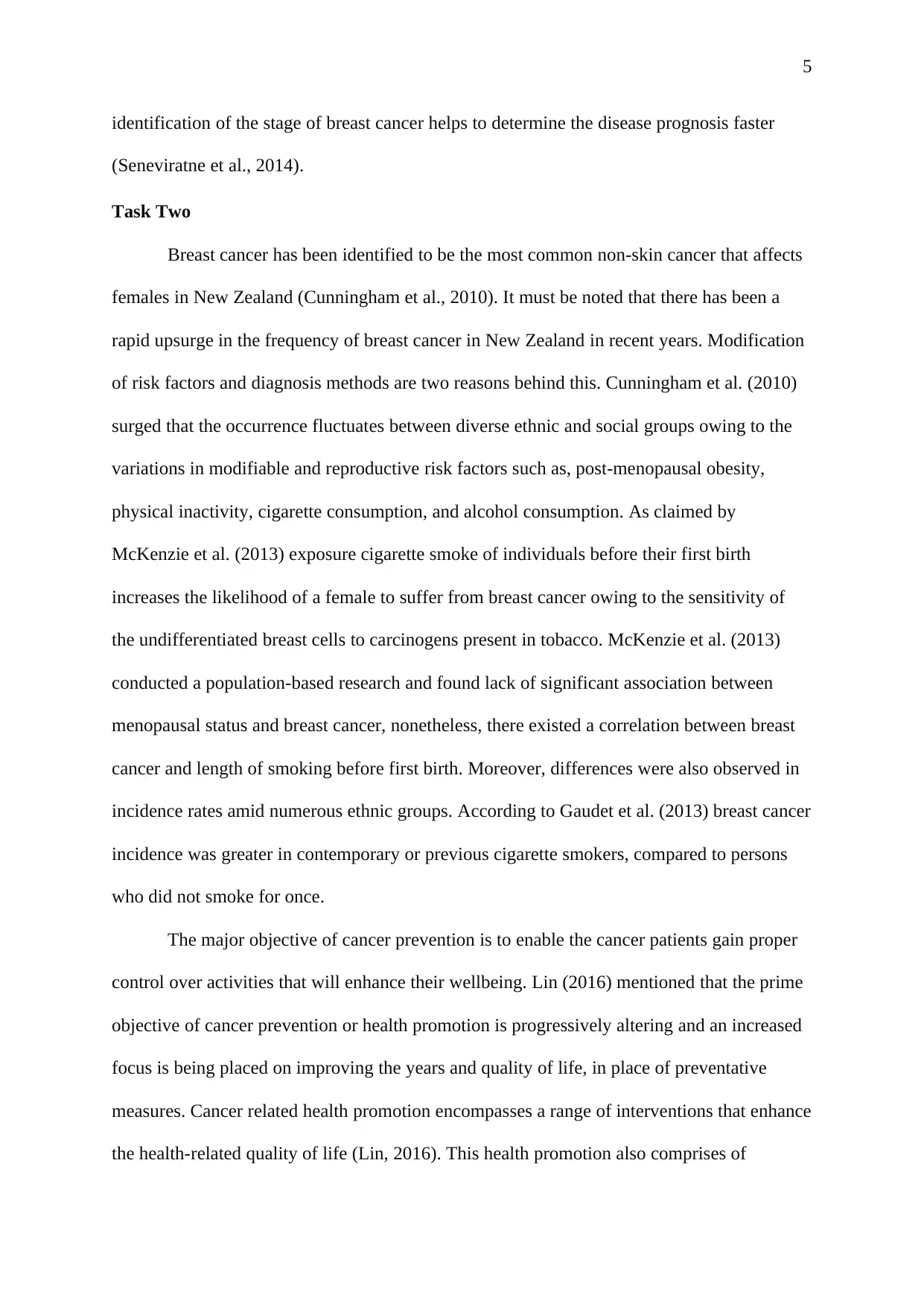
5
identification of the stage of breast cancer helps to determine the disease prognosis faster
(Seneviratne et al., 2014).
Task Two
Breast cancer has been identified to be the most common non-skin cancer that affects
females in New Zealand (Cunningham et al., 2010). It must be noted that there has been a
rapid upsurge in the frequency of breast cancer in New Zealand in recent years. Modification
of risk factors and diagnosis methods are two reasons behind this. Cunningham et al. (2010)
surged that the occurrence fluctuates between diverse ethnic and social groups owing to the
variations in modifiable and reproductive risk factors such as, post-menopausal obesity,
physical inactivity, cigarette consumption, and alcohol consumption. As claimed by
McKenzie et al. (2013) exposure cigarette smoke of individuals before their first birth
increases the likelihood of a female to suffer from breast cancer owing to the sensitivity of
the undifferentiated breast cells to carcinogens present in tobacco. McKenzie et al. (2013)
conducted a population-based research and found lack of significant association between
menopausal status and breast cancer, nonetheless, there existed a correlation between breast
cancer and length of smoking before first birth. Moreover, differences were also observed in
incidence rates amid numerous ethnic groups. According to Gaudet et al. (2013) breast cancer
incidence was greater in contemporary or previous cigarette smokers, compared to persons
who did not smoke for once.
The major objective of cancer prevention is to enable the cancer patients gain proper
control over activities that will enhance their wellbeing. Lin (2016) mentioned that the prime
objective of cancer prevention or health promotion is progressively altering and an increased
focus is being placed on improving the years and quality of life, in place of preventative
measures. Cancer related health promotion encompasses a range of interventions that enhance
the health-related quality of life (Lin, 2016). This health promotion also comprises of
identification of the stage of breast cancer helps to determine the disease prognosis faster
(Seneviratne et al., 2014).
Task Two
Breast cancer has been identified to be the most common non-skin cancer that affects
females in New Zealand (Cunningham et al., 2010). It must be noted that there has been a
rapid upsurge in the frequency of breast cancer in New Zealand in recent years. Modification
of risk factors and diagnosis methods are two reasons behind this. Cunningham et al. (2010)
surged that the occurrence fluctuates between diverse ethnic and social groups owing to the
variations in modifiable and reproductive risk factors such as, post-menopausal obesity,
physical inactivity, cigarette consumption, and alcohol consumption. As claimed by
McKenzie et al. (2013) exposure cigarette smoke of individuals before their first birth
increases the likelihood of a female to suffer from breast cancer owing to the sensitivity of
the undifferentiated breast cells to carcinogens present in tobacco. McKenzie et al. (2013)
conducted a population-based research and found lack of significant association between
menopausal status and breast cancer, nonetheless, there existed a correlation between breast
cancer and length of smoking before first birth. Moreover, differences were also observed in
incidence rates amid numerous ethnic groups. According to Gaudet et al. (2013) breast cancer
incidence was greater in contemporary or previous cigarette smokers, compared to persons
who did not smoke for once.
The major objective of cancer prevention is to enable the cancer patients gain proper
control over activities that will enhance their wellbeing. Lin (2016) mentioned that the prime
objective of cancer prevention or health promotion is progressively altering and an increased
focus is being placed on improving the years and quality of life, in place of preventative
measures. Cancer related health promotion encompasses a range of interventions that enhance
the health-related quality of life (Lin, 2016). This health promotion also comprises of
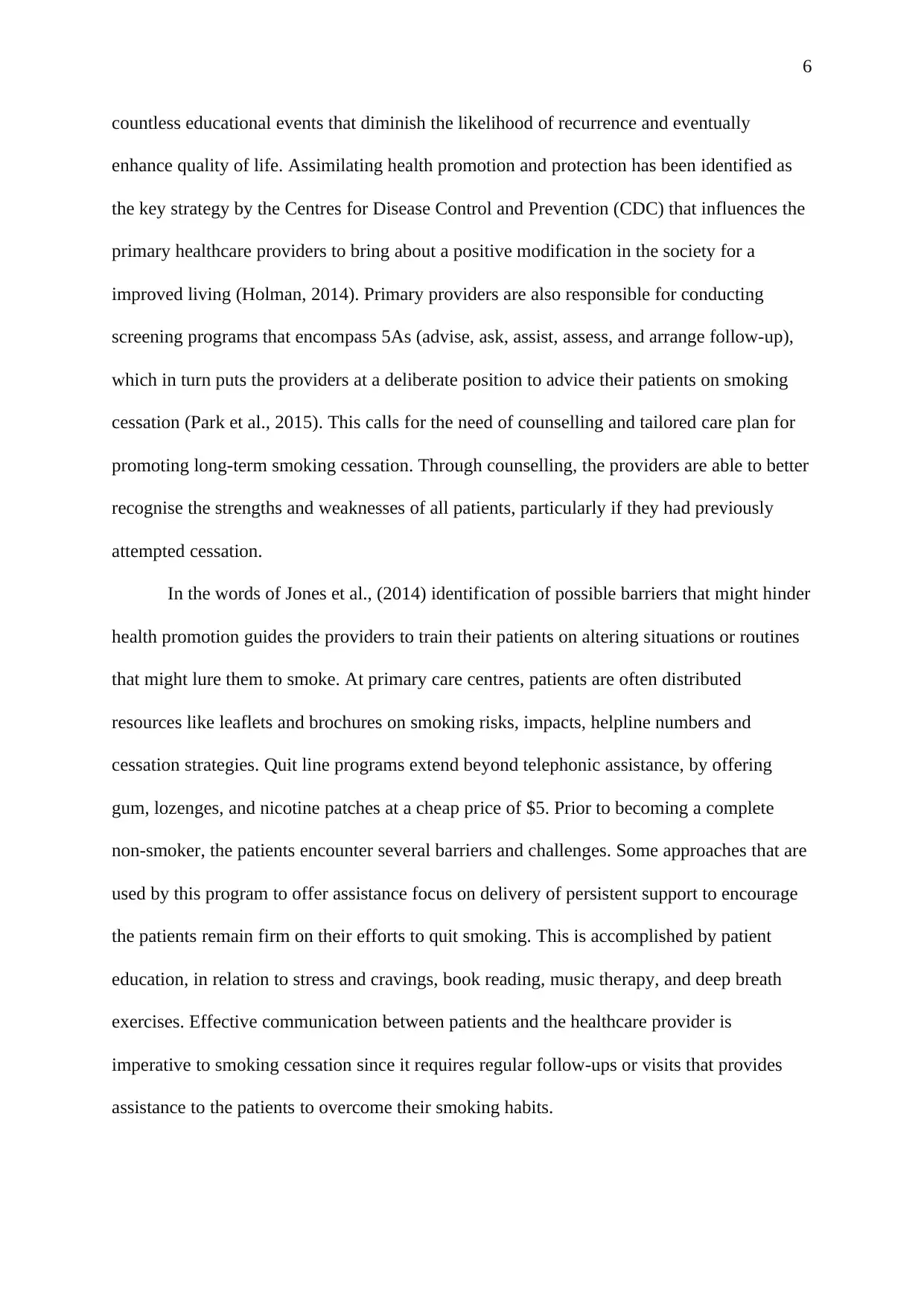
6
countless educational events that diminish the likelihood of recurrence and eventually
enhance quality of life. Assimilating health promotion and protection has been identified as
the key strategy by the Centres for Disease Control and Prevention (CDC) that influences the
primary healthcare providers to bring about a positive modification in the society for a
improved living (Holman, 2014). Primary providers are also responsible for conducting
screening programs that encompass 5As (advise, ask, assist, assess, and arrange follow-up),
which in turn puts the providers at a deliberate position to advice their patients on smoking
cessation (Park et al., 2015). This calls for the need of counselling and tailored care plan for
promoting long-term smoking cessation. Through counselling, the providers are able to better
recognise the strengths and weaknesses of all patients, particularly if they had previously
attempted cessation.
In the words of Jones et al., (2014) identification of possible barriers that might hinder
health promotion guides the providers to train their patients on altering situations or routines
that might lure them to smoke. At primary care centres, patients are often distributed
resources like leaflets and brochures on smoking risks, impacts, helpline numbers and
cessation strategies. Quit line programs extend beyond telephonic assistance, by offering
gum, lozenges, and nicotine patches at a cheap price of $5. Prior to becoming a complete
non-smoker, the patients encounter several barriers and challenges. Some approaches that are
used by this program to offer assistance focus on delivery of persistent support to encourage
the patients remain firm on their efforts to quit smoking. This is accomplished by patient
education, in relation to stress and cravings, book reading, music therapy, and deep breath
exercises. Effective communication between patients and the healthcare provider is
imperative to smoking cessation since it requires regular follow-ups or visits that provides
assistance to the patients to overcome their smoking habits.
countless educational events that diminish the likelihood of recurrence and eventually
enhance quality of life. Assimilating health promotion and protection has been identified as
the key strategy by the Centres for Disease Control and Prevention (CDC) that influences the
primary healthcare providers to bring about a positive modification in the society for a
improved living (Holman, 2014). Primary providers are also responsible for conducting
screening programs that encompass 5As (advise, ask, assist, assess, and arrange follow-up),
which in turn puts the providers at a deliberate position to advice their patients on smoking
cessation (Park et al., 2015). This calls for the need of counselling and tailored care plan for
promoting long-term smoking cessation. Through counselling, the providers are able to better
recognise the strengths and weaknesses of all patients, particularly if they had previously
attempted cessation.
In the words of Jones et al., (2014) identification of possible barriers that might hinder
health promotion guides the providers to train their patients on altering situations or routines
that might lure them to smoke. At primary care centres, patients are often distributed
resources like leaflets and brochures on smoking risks, impacts, helpline numbers and
cessation strategies. Quit line programs extend beyond telephonic assistance, by offering
gum, lozenges, and nicotine patches at a cheap price of $5. Prior to becoming a complete
non-smoker, the patients encounter several barriers and challenges. Some approaches that are
used by this program to offer assistance focus on delivery of persistent support to encourage
the patients remain firm on their efforts to quit smoking. This is accomplished by patient
education, in relation to stress and cravings, book reading, music therapy, and deep breath
exercises. Effective communication between patients and the healthcare provider is
imperative to smoking cessation since it requires regular follow-ups or visits that provides
assistance to the patients to overcome their smoking habits.
⊘ This is a preview!⊘
Do you want full access?
Subscribe today to unlock all pages.

Trusted by 1+ million students worldwide
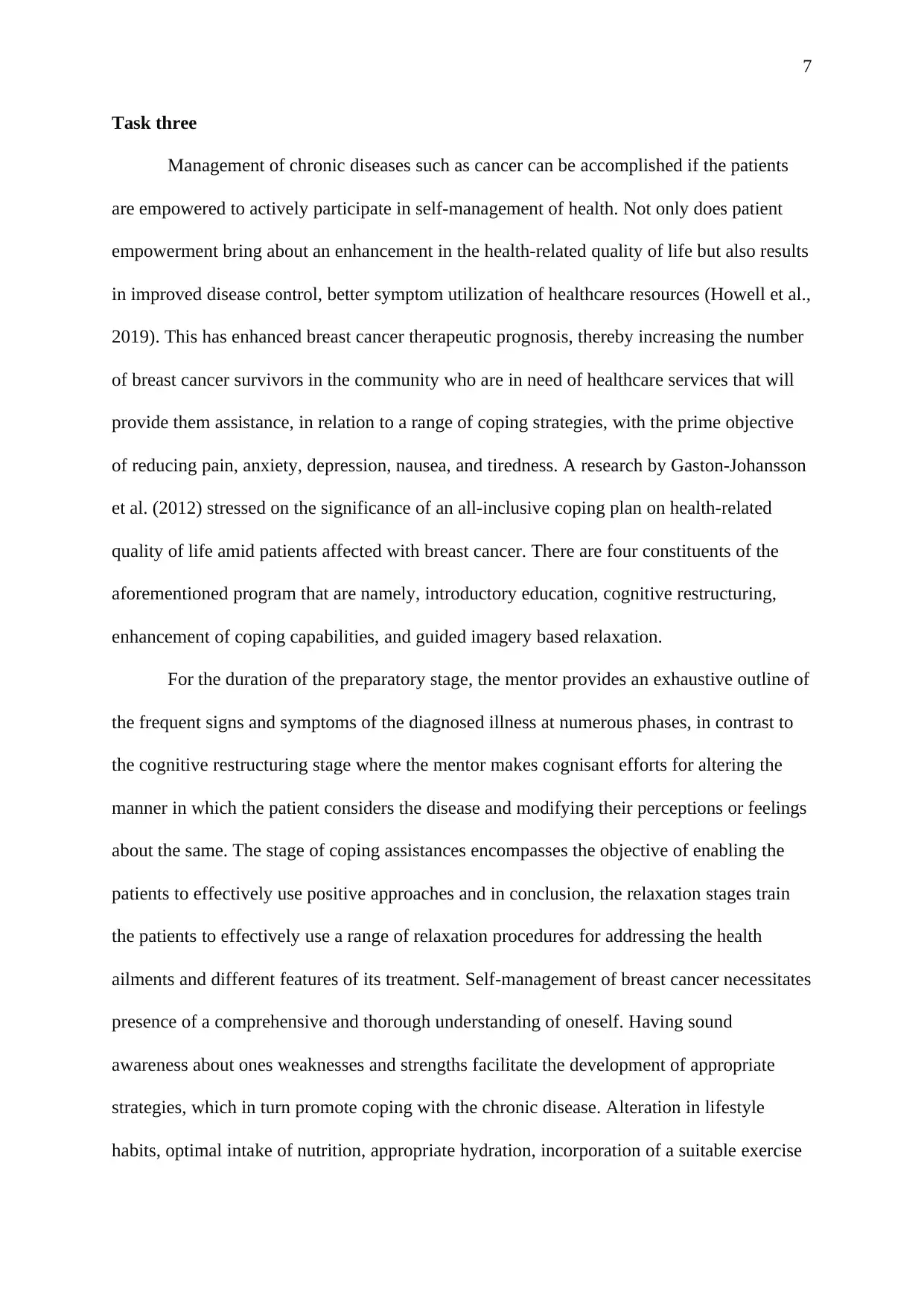
7
Task three
Management of chronic diseases such as cancer can be accomplished if the patients
are empowered to actively participate in self-management of health. Not only does patient
empowerment bring about an enhancement in the health-related quality of life but also results
in improved disease control, better symptom utilization of healthcare resources (Howell et al.,
2019). This has enhanced breast cancer therapeutic prognosis, thereby increasing the number
of breast cancer survivors in the community who are in need of healthcare services that will
provide them assistance, in relation to a range of coping strategies, with the prime objective
of reducing pain, anxiety, depression, nausea, and tiredness. A research by Gaston-Johansson
et al. (2012) stressed on the significance of an all-inclusive coping plan on health-related
quality of life amid patients affected with breast cancer. There are four constituents of the
aforementioned program that are namely, introductory education, cognitive restructuring,
enhancement of coping capabilities, and guided imagery based relaxation.
For the duration of the preparatory stage, the mentor provides an exhaustive outline of
the frequent signs and symptoms of the diagnosed illness at numerous phases, in contrast to
the cognitive restructuring stage where the mentor makes cognisant efforts for altering the
manner in which the patient considers the disease and modifying their perceptions or feelings
about the same. The stage of coping assistances encompasses the objective of enabling the
patients to effectively use positive approaches and in conclusion, the relaxation stages train
the patients to effectively use a range of relaxation procedures for addressing the health
ailments and different features of its treatment. Self-management of breast cancer necessitates
presence of a comprehensive and thorough understanding of oneself. Having sound
awareness about ones weaknesses and strengths facilitate the development of appropriate
strategies, which in turn promote coping with the chronic disease. Alteration in lifestyle
habits, optimal intake of nutrition, appropriate hydration, incorporation of a suitable exercise
Task three
Management of chronic diseases such as cancer can be accomplished if the patients
are empowered to actively participate in self-management of health. Not only does patient
empowerment bring about an enhancement in the health-related quality of life but also results
in improved disease control, better symptom utilization of healthcare resources (Howell et al.,
2019). This has enhanced breast cancer therapeutic prognosis, thereby increasing the number
of breast cancer survivors in the community who are in need of healthcare services that will
provide them assistance, in relation to a range of coping strategies, with the prime objective
of reducing pain, anxiety, depression, nausea, and tiredness. A research by Gaston-Johansson
et al. (2012) stressed on the significance of an all-inclusive coping plan on health-related
quality of life amid patients affected with breast cancer. There are four constituents of the
aforementioned program that are namely, introductory education, cognitive restructuring,
enhancement of coping capabilities, and guided imagery based relaxation.
For the duration of the preparatory stage, the mentor provides an exhaustive outline of
the frequent signs and symptoms of the diagnosed illness at numerous phases, in contrast to
the cognitive restructuring stage where the mentor makes cognisant efforts for altering the
manner in which the patient considers the disease and modifying their perceptions or feelings
about the same. The stage of coping assistances encompasses the objective of enabling the
patients to effectively use positive approaches and in conclusion, the relaxation stages train
the patients to effectively use a range of relaxation procedures for addressing the health
ailments and different features of its treatment. Self-management of breast cancer necessitates
presence of a comprehensive and thorough understanding of oneself. Having sound
awareness about ones weaknesses and strengths facilitate the development of appropriate
strategies, which in turn promote coping with the chronic disease. Alteration in lifestyle
habits, optimal intake of nutrition, appropriate hydration, incorporation of a suitable exercise
Paraphrase This Document
Need a fresh take? Get an instant paraphrase of this document with our AI Paraphraser
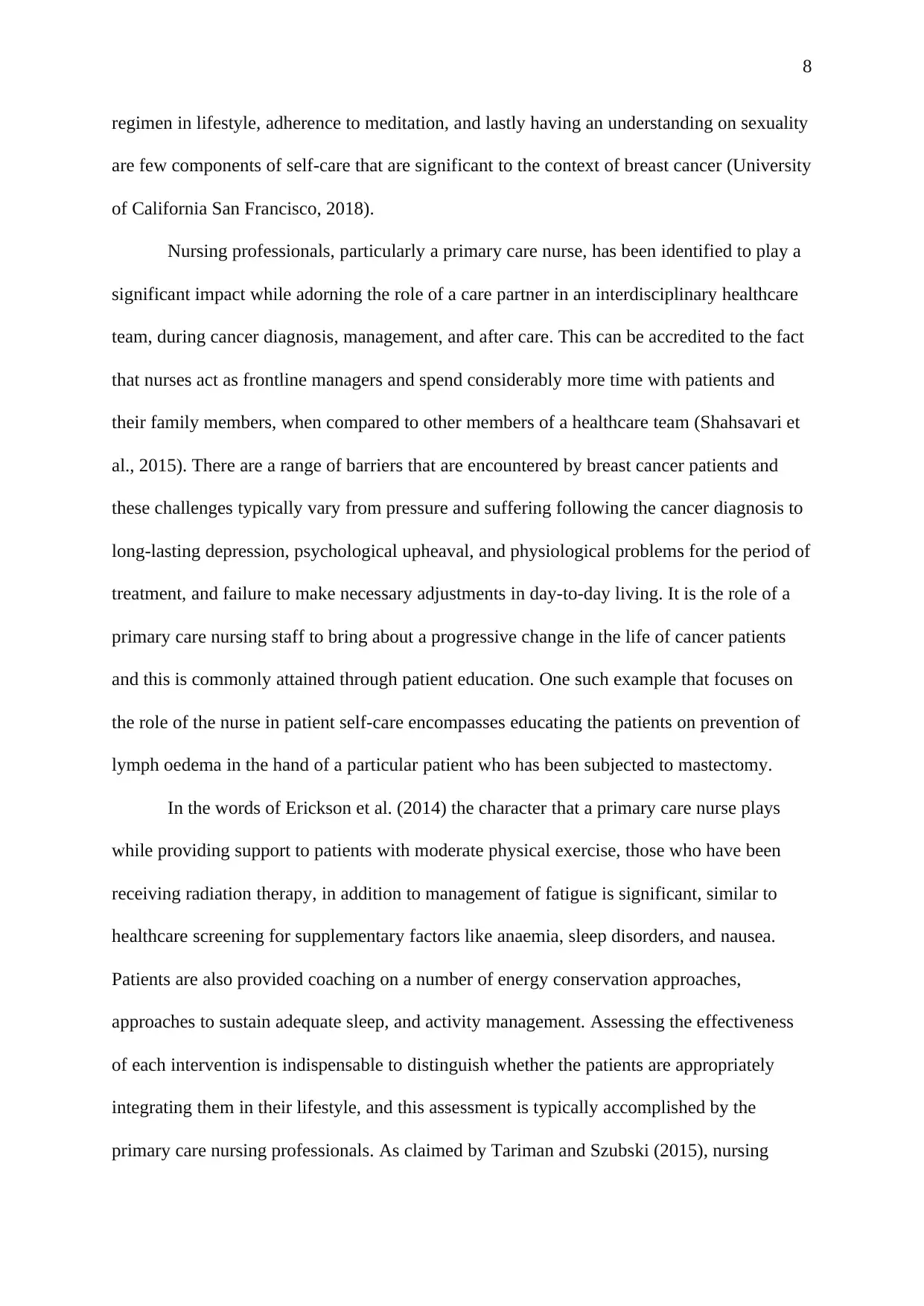
8
regimen in lifestyle, adherence to meditation, and lastly having an understanding on sexuality
are few components of self-care that are significant to the context of breast cancer (University
of California San Francisco, 2018).
Nursing professionals, particularly a primary care nurse, has been identified to play a
significant impact while adorning the role of a care partner in an interdisciplinary healthcare
team, during cancer diagnosis, management, and after care. This can be accredited to the fact
that nurses act as frontline managers and spend considerably more time with patients and
their family members, when compared to other members of a healthcare team (Shahsavari et
al., 2015). There are a range of barriers that are encountered by breast cancer patients and
these challenges typically vary from pressure and suffering following the cancer diagnosis to
long-lasting depression, psychological upheaval, and physiological problems for the period of
treatment, and failure to make necessary adjustments in day-to-day living. It is the role of a
primary care nursing staff to bring about a progressive change in the life of cancer patients
and this is commonly attained through patient education. One such example that focuses on
the role of the nurse in patient self-care encompasses educating the patients on prevention of
lymph oedema in the hand of a particular patient who has been subjected to mastectomy.
In the words of Erickson et al. (2014) the character that a primary care nurse plays
while providing support to patients with moderate physical exercise, those who have been
receiving radiation therapy, in addition to management of fatigue is significant, similar to
healthcare screening for supplementary factors like anaemia, sleep disorders, and nausea.
Patients are also provided coaching on a number of energy conservation approaches,
approaches to sustain adequate sleep, and activity management. Assessing the effectiveness
of each intervention is indispensable to distinguish whether the patients are appropriately
integrating them in their lifestyle, and this assessment is typically accomplished by the
primary care nursing professionals. As claimed by Tariman and Szubski (2015), nursing
regimen in lifestyle, adherence to meditation, and lastly having an understanding on sexuality
are few components of self-care that are significant to the context of breast cancer (University
of California San Francisco, 2018).
Nursing professionals, particularly a primary care nurse, has been identified to play a
significant impact while adorning the role of a care partner in an interdisciplinary healthcare
team, during cancer diagnosis, management, and after care. This can be accredited to the fact
that nurses act as frontline managers and spend considerably more time with patients and
their family members, when compared to other members of a healthcare team (Shahsavari et
al., 2015). There are a range of barriers that are encountered by breast cancer patients and
these challenges typically vary from pressure and suffering following the cancer diagnosis to
long-lasting depression, psychological upheaval, and physiological problems for the period of
treatment, and failure to make necessary adjustments in day-to-day living. It is the role of a
primary care nursing staff to bring about a progressive change in the life of cancer patients
and this is commonly attained through patient education. One such example that focuses on
the role of the nurse in patient self-care encompasses educating the patients on prevention of
lymph oedema in the hand of a particular patient who has been subjected to mastectomy.
In the words of Erickson et al. (2014) the character that a primary care nurse plays
while providing support to patients with moderate physical exercise, those who have been
receiving radiation therapy, in addition to management of fatigue is significant, similar to
healthcare screening for supplementary factors like anaemia, sleep disorders, and nausea.
Patients are also provided coaching on a number of energy conservation approaches,
approaches to sustain adequate sleep, and activity management. Assessing the effectiveness
of each intervention is indispensable to distinguish whether the patients are appropriately
integrating them in their lifestyle, and this assessment is typically accomplished by the
primary care nursing professionals. As claimed by Tariman and Szubski (2015), nursing
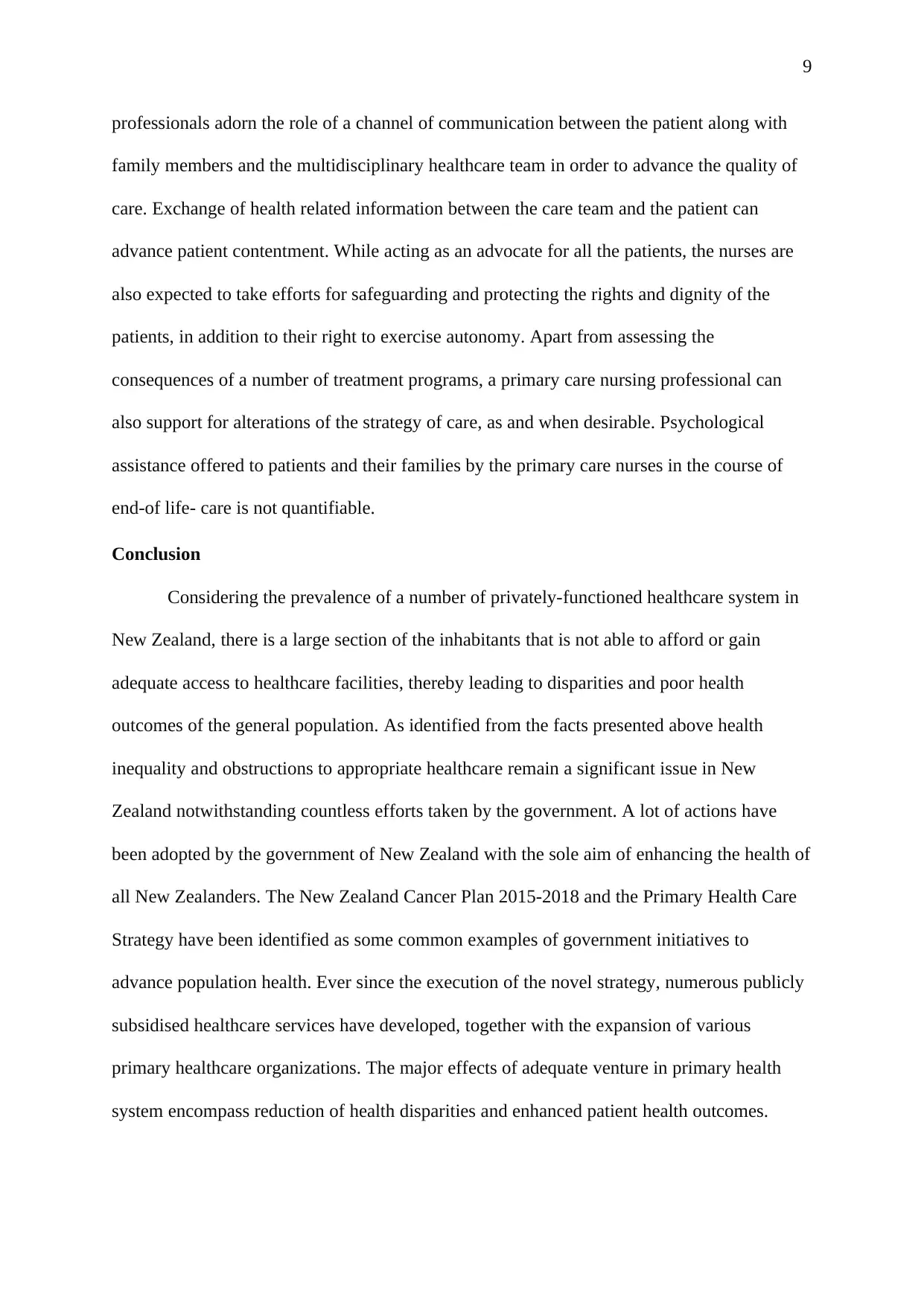
9
professionals adorn the role of a channel of communication between the patient along with
family members and the multidisciplinary healthcare team in order to advance the quality of
care. Exchange of health related information between the care team and the patient can
advance patient contentment. While acting as an advocate for all the patients, the nurses are
also expected to take efforts for safeguarding and protecting the rights and dignity of the
patients, in addition to their right to exercise autonomy. Apart from assessing the
consequences of a number of treatment programs, a primary care nursing professional can
also support for alterations of the strategy of care, as and when desirable. Psychological
assistance offered to patients and their families by the primary care nurses in the course of
end-of life- care is not quantifiable.
Conclusion
Considering the prevalence of a number of privately-functioned healthcare system in
New Zealand, there is a large section of the inhabitants that is not able to afford or gain
adequate access to healthcare facilities, thereby leading to disparities and poor health
outcomes of the general population. As identified from the facts presented above health
inequality and obstructions to appropriate healthcare remain a significant issue in New
Zealand notwithstanding countless efforts taken by the government. A lot of actions have
been adopted by the government of New Zealand with the sole aim of enhancing the health of
all New Zealanders. The New Zealand Cancer Plan 2015-2018 and the Primary Health Care
Strategy have been identified as some common examples of government initiatives to
advance population health. Ever since the execution of the novel strategy, numerous publicly
subsidised healthcare services have developed, together with the expansion of various
primary healthcare organizations. The major effects of adequate venture in primary health
system encompass reduction of health disparities and enhanced patient health outcomes.
professionals adorn the role of a channel of communication between the patient along with
family members and the multidisciplinary healthcare team in order to advance the quality of
care. Exchange of health related information between the care team and the patient can
advance patient contentment. While acting as an advocate for all the patients, the nurses are
also expected to take efforts for safeguarding and protecting the rights and dignity of the
patients, in addition to their right to exercise autonomy. Apart from assessing the
consequences of a number of treatment programs, a primary care nursing professional can
also support for alterations of the strategy of care, as and when desirable. Psychological
assistance offered to patients and their families by the primary care nurses in the course of
end-of life- care is not quantifiable.
Conclusion
Considering the prevalence of a number of privately-functioned healthcare system in
New Zealand, there is a large section of the inhabitants that is not able to afford or gain
adequate access to healthcare facilities, thereby leading to disparities and poor health
outcomes of the general population. As identified from the facts presented above health
inequality and obstructions to appropriate healthcare remain a significant issue in New
Zealand notwithstanding countless efforts taken by the government. A lot of actions have
been adopted by the government of New Zealand with the sole aim of enhancing the health of
all New Zealanders. The New Zealand Cancer Plan 2015-2018 and the Primary Health Care
Strategy have been identified as some common examples of government initiatives to
advance population health. Ever since the execution of the novel strategy, numerous publicly
subsidised healthcare services have developed, together with the expansion of various
primary healthcare organizations. The major effects of adequate venture in primary health
system encompass reduction of health disparities and enhanced patient health outcomes.
⊘ This is a preview!⊘
Do you want full access?
Subscribe today to unlock all pages.

Trusted by 1+ million students worldwide
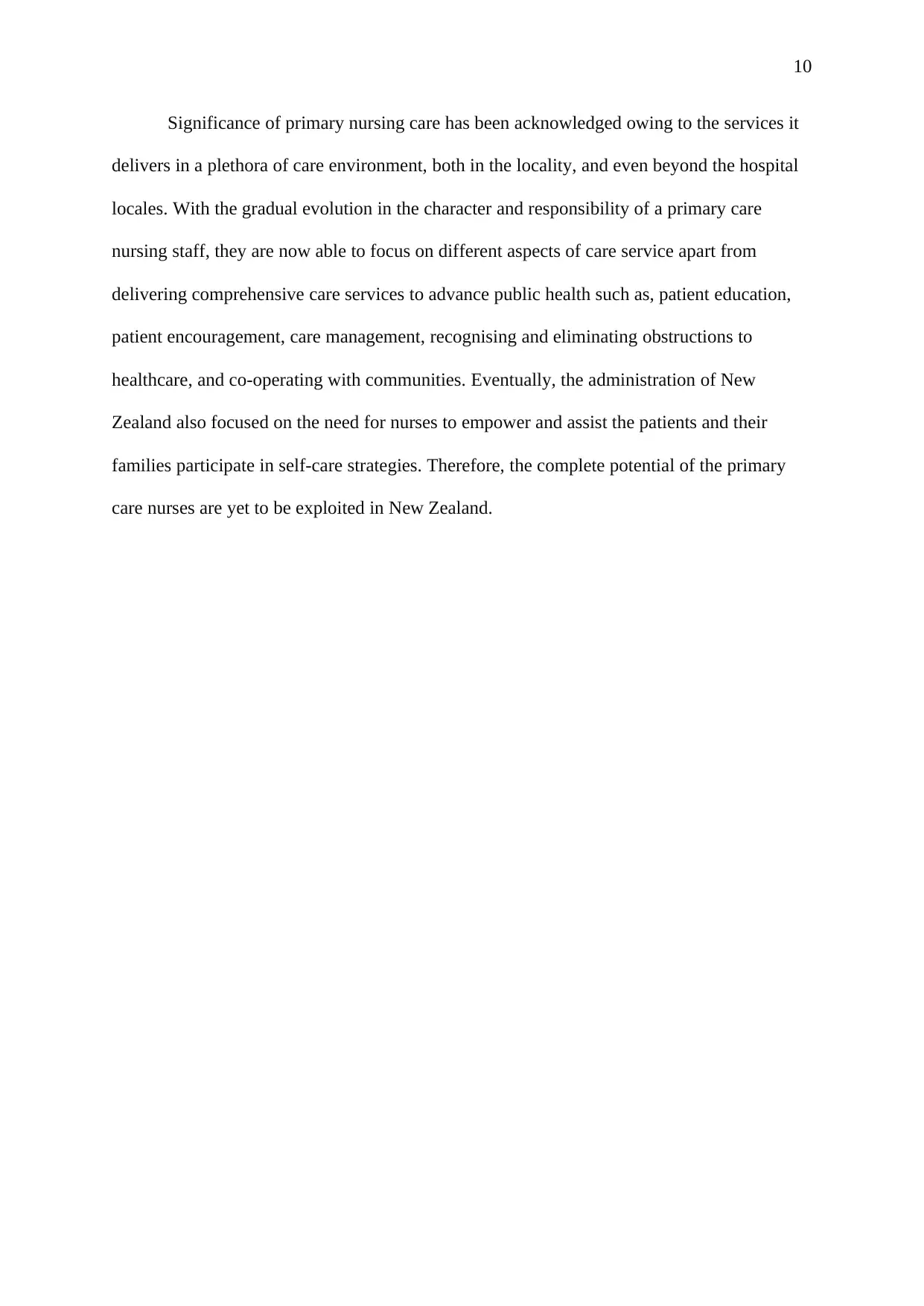
10
Significance of primary nursing care has been acknowledged owing to the services it
delivers in a plethora of care environment, both in the locality, and even beyond the hospital
locales. With the gradual evolution in the character and responsibility of a primary care
nursing staff, they are now able to focus on different aspects of care service apart from
delivering comprehensive care services to advance public health such as, patient education,
patient encouragement, care management, recognising and eliminating obstructions to
healthcare, and co-operating with communities. Eventually, the administration of New
Zealand also focused on the need for nurses to empower and assist the patients and their
families participate in self-care strategies. Therefore, the complete potential of the primary
care nurses are yet to be exploited in New Zealand.
Significance of primary nursing care has been acknowledged owing to the services it
delivers in a plethora of care environment, both in the locality, and even beyond the hospital
locales. With the gradual evolution in the character and responsibility of a primary care
nursing staff, they are now able to focus on different aspects of care service apart from
delivering comprehensive care services to advance public health such as, patient education,
patient encouragement, care management, recognising and eliminating obstructions to
healthcare, and co-operating with communities. Eventually, the administration of New
Zealand also focused on the need for nurses to empower and assist the patients and their
families participate in self-care strategies. Therefore, the complete potential of the primary
care nurses are yet to be exploited in New Zealand.
Paraphrase This Document
Need a fresh take? Get an instant paraphrase of this document with our AI Paraphraser
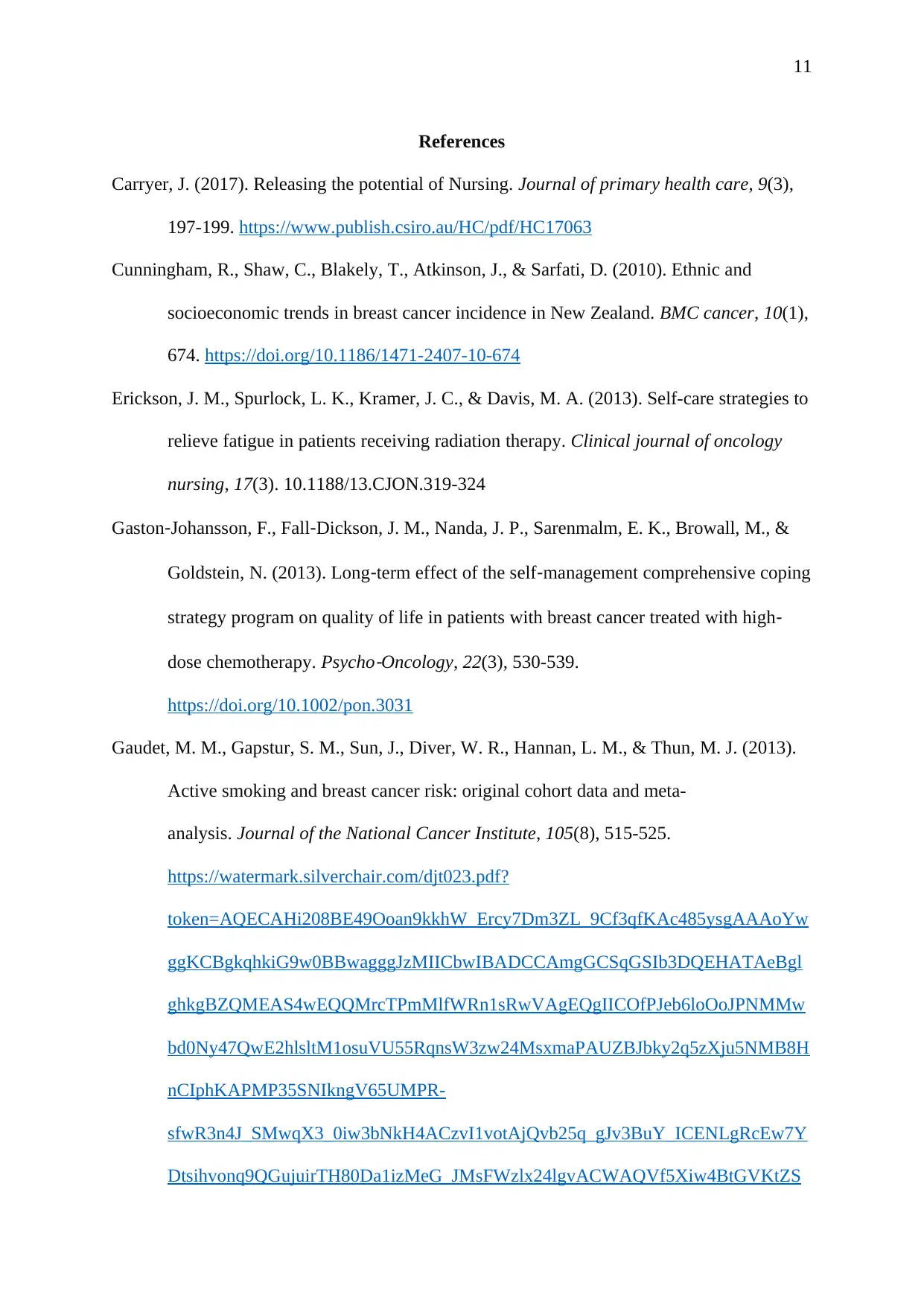
11
References
Carryer, J. (2017). Releasing the potential of Nursing. Journal of primary health care, 9(3),
197-199. https://www.publish.csiro.au/HC/pdf/HC17063
Cunningham, R., Shaw, C., Blakely, T., Atkinson, J., & Sarfati, D. (2010). Ethnic and
socioeconomic trends in breast cancer incidence in New Zealand. BMC cancer, 10(1),
674. https://doi.org/10.1186/1471-2407-10-674
Erickson, J. M., Spurlock, L. K., Kramer, J. C., & Davis, M. A. (2013). Self-care strategies to
relieve fatigue in patients receiving radiation therapy. Clinical journal of oncology
nursing, 17(3). 10.1188/13.CJON.319-324
Gaston‐Johansson, F., Fall‐Dickson, J. M., Nanda, J. P., Sarenmalm, E. K., Browall, M., &
Goldstein, N. (2013). Long‐term effect of the self‐management comprehensive coping
strategy program on quality of life in patients with breast cancer treated with high‐
dose chemotherapy. Psycho
‐Oncology, 22(3), 530-539.
https://doi.org/10.1002/pon.3031
Gaudet, M. M., Gapstur, S. M., Sun, J., Diver, W. R., Hannan, L. M., & Thun, M. J. (2013).
Active smoking and breast cancer risk: original cohort data and meta-
analysis. Journal of the National Cancer Institute, 105(8), 515-525.
https://watermark.silverchair.com/djt023.pdf?
token=AQECAHi208BE49Ooan9kkhW_Ercy7Dm3ZL_9Cf3qfKAc485ysgAAAoYw
ggKCBgkqhkiG9w0BBwagggJzMIICbwIBADCCAmgGCSqGSIb3DQEHATAeBgl
ghkgBZQMEAS4wEQQMrcTPmMlfWRn1sRwVAgEQgIICOfPJeb6loOoJPNMMw
bd0Ny47QwE2hlsltM1osuVU55RqnsW3zw24MsxmaPAUZBJbky2q5zXju5NMB8H
nCIphKAPMP35SNIkngV65UMPR-
sfwR3n4J_SMwqX3_0iw3bNkH4ACzvI1votAjQvb25q_gJv3BuY_ICENLgRcEw7Y
Dtsihvonq9QGujuirTH80Da1izMeG_JMsFWzlx24lgvACWAQVf5Xiw4BtGVKtZS
References
Carryer, J. (2017). Releasing the potential of Nursing. Journal of primary health care, 9(3),
197-199. https://www.publish.csiro.au/HC/pdf/HC17063
Cunningham, R., Shaw, C., Blakely, T., Atkinson, J., & Sarfati, D. (2010). Ethnic and
socioeconomic trends in breast cancer incidence in New Zealand. BMC cancer, 10(1),
674. https://doi.org/10.1186/1471-2407-10-674
Erickson, J. M., Spurlock, L. K., Kramer, J. C., & Davis, M. A. (2013). Self-care strategies to
relieve fatigue in patients receiving radiation therapy. Clinical journal of oncology
nursing, 17(3). 10.1188/13.CJON.319-324
Gaston‐Johansson, F., Fall‐Dickson, J. M., Nanda, J. P., Sarenmalm, E. K., Browall, M., &
Goldstein, N. (2013). Long‐term effect of the self‐management comprehensive coping
strategy program on quality of life in patients with breast cancer treated with high‐
dose chemotherapy. Psycho
‐Oncology, 22(3), 530-539.
https://doi.org/10.1002/pon.3031
Gaudet, M. M., Gapstur, S. M., Sun, J., Diver, W. R., Hannan, L. M., & Thun, M. J. (2013).
Active smoking and breast cancer risk: original cohort data and meta-
analysis. Journal of the National Cancer Institute, 105(8), 515-525.
https://watermark.silverchair.com/djt023.pdf?
token=AQECAHi208BE49Ooan9kkhW_Ercy7Dm3ZL_9Cf3qfKAc485ysgAAAoYw
ggKCBgkqhkiG9w0BBwagggJzMIICbwIBADCCAmgGCSqGSIb3DQEHATAeBgl
ghkgBZQMEAS4wEQQMrcTPmMlfWRn1sRwVAgEQgIICOfPJeb6loOoJPNMMw
bd0Ny47QwE2hlsltM1osuVU55RqnsW3zw24MsxmaPAUZBJbky2q5zXju5NMB8H
nCIphKAPMP35SNIkngV65UMPR-
sfwR3n4J_SMwqX3_0iw3bNkH4ACzvI1votAjQvb25q_gJv3BuY_ICENLgRcEw7Y
Dtsihvonq9QGujuirTH80Da1izMeG_JMsFWzlx24lgvACWAQVf5Xiw4BtGVKtZS
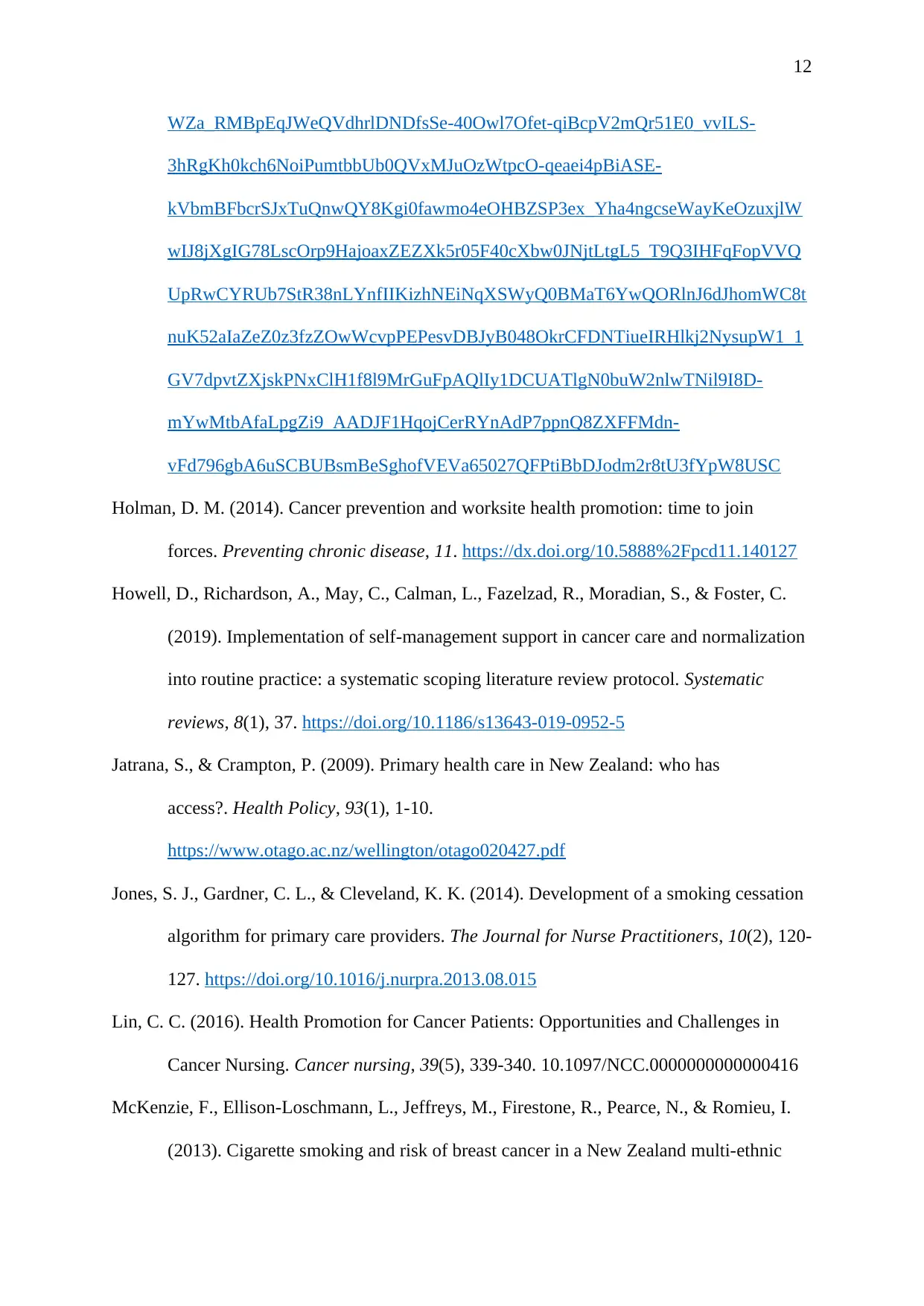
12
WZa_RMBpEqJWeQVdhrlDNDfsSe-40Owl7Ofet-qiBcpV2mQr51E0_vvILS-
3hRgKh0kch6NoiPumtbbUb0QVxMJuOzWtpcO-qeaei4pBiASE-
kVbmBFbcrSJxTuQnwQY8Kgi0fawmo4eOHBZSP3ex_Yha4ngcseWayKeOzuxjlW
wIJ8jXgIG78LscOrp9HajoaxZEZXk5r05F40cXbw0JNjtLtgL5_T9Q3IHFqFopVVQ
UpRwCYRUb7StR38nLYnfIIKizhNEiNqXSWyQ0BMaT6YwQORlnJ6dJhomWC8t
nuK52aIaZeZ0z3fzZOwWcvpPEPesvDBJyB048OkrCFDNTiueIRHlkj2NysupW1_1
GV7dpvtZXjskPNxClH1f8l9MrGuFpAQlIy1DCUATlgN0buW2nlwTNil9I8D-
mYwMtbAfaLpgZi9_AADJF1HqojCerRYnAdP7ppnQ8ZXFFMdn-
vFd796gbA6uSCBUBsmBeSghofVEVa65027QFPtiBbDJodm2r8tU3fYpW8USC
Holman, D. M. (2014). Cancer prevention and worksite health promotion: time to join
forces. Preventing chronic disease, 11. https://dx.doi.org/10.5888%2Fpcd11.140127
Howell, D., Richardson, A., May, C., Calman, L., Fazelzad, R., Moradian, S., & Foster, C.
(2019). Implementation of self-management support in cancer care and normalization
into routine practice: a systematic scoping literature review protocol. Systematic
reviews, 8(1), 37. https://doi.org/10.1186/s13643-019-0952-5
Jatrana, S., & Crampton, P. (2009). Primary health care in New Zealand: who has
access?. Health Policy, 93(1), 1-10.
https://www.otago.ac.nz/wellington/otago020427.pdf
Jones, S. J., Gardner, C. L., & Cleveland, K. K. (2014). Development of a smoking cessation
algorithm for primary care providers. The Journal for Nurse Practitioners, 10(2), 120-
127. https://doi.org/10.1016/j.nurpra.2013.08.015
Lin, C. C. (2016). Health Promotion for Cancer Patients: Opportunities and Challenges in
Cancer Nursing. Cancer nursing, 39(5), 339-340. 10.1097/NCC.0000000000000416
McKenzie, F., Ellison-Loschmann, L., Jeffreys, M., Firestone, R., Pearce, N., & Romieu, I.
(2013). Cigarette smoking and risk of breast cancer in a New Zealand multi-ethnic
WZa_RMBpEqJWeQVdhrlDNDfsSe-40Owl7Ofet-qiBcpV2mQr51E0_vvILS-
3hRgKh0kch6NoiPumtbbUb0QVxMJuOzWtpcO-qeaei4pBiASE-
kVbmBFbcrSJxTuQnwQY8Kgi0fawmo4eOHBZSP3ex_Yha4ngcseWayKeOzuxjlW
wIJ8jXgIG78LscOrp9HajoaxZEZXk5r05F40cXbw0JNjtLtgL5_T9Q3IHFqFopVVQ
UpRwCYRUb7StR38nLYnfIIKizhNEiNqXSWyQ0BMaT6YwQORlnJ6dJhomWC8t
nuK52aIaZeZ0z3fzZOwWcvpPEPesvDBJyB048OkrCFDNTiueIRHlkj2NysupW1_1
GV7dpvtZXjskPNxClH1f8l9MrGuFpAQlIy1DCUATlgN0buW2nlwTNil9I8D-
mYwMtbAfaLpgZi9_AADJF1HqojCerRYnAdP7ppnQ8ZXFFMdn-
vFd796gbA6uSCBUBsmBeSghofVEVa65027QFPtiBbDJodm2r8tU3fYpW8USC
Holman, D. M. (2014). Cancer prevention and worksite health promotion: time to join
forces. Preventing chronic disease, 11. https://dx.doi.org/10.5888%2Fpcd11.140127
Howell, D., Richardson, A., May, C., Calman, L., Fazelzad, R., Moradian, S., & Foster, C.
(2019). Implementation of self-management support in cancer care and normalization
into routine practice: a systematic scoping literature review protocol. Systematic
reviews, 8(1), 37. https://doi.org/10.1186/s13643-019-0952-5
Jatrana, S., & Crampton, P. (2009). Primary health care in New Zealand: who has
access?. Health Policy, 93(1), 1-10.
https://www.otago.ac.nz/wellington/otago020427.pdf
Jones, S. J., Gardner, C. L., & Cleveland, K. K. (2014). Development of a smoking cessation
algorithm for primary care providers. The Journal for Nurse Practitioners, 10(2), 120-
127. https://doi.org/10.1016/j.nurpra.2013.08.015
Lin, C. C. (2016). Health Promotion for Cancer Patients: Opportunities and Challenges in
Cancer Nursing. Cancer nursing, 39(5), 339-340. 10.1097/NCC.0000000000000416
McKenzie, F., Ellison-Loschmann, L., Jeffreys, M., Firestone, R., Pearce, N., & Romieu, I.
(2013). Cigarette smoking and risk of breast cancer in a New Zealand multi-ethnic
⊘ This is a preview!⊘
Do you want full access?
Subscribe today to unlock all pages.

Trusted by 1+ million students worldwide
1 out of 15
Related Documents
Your All-in-One AI-Powered Toolkit for Academic Success.
+13062052269
info@desklib.com
Available 24*7 on WhatsApp / Email
![[object Object]](/_next/static/media/star-bottom.7253800d.svg)
Unlock your academic potential
Copyright © 2020–2025 A2Z Services. All Rights Reserved. Developed and managed by ZUCOL.





